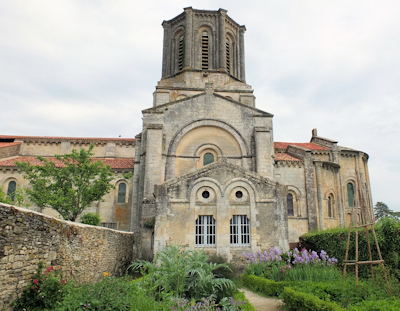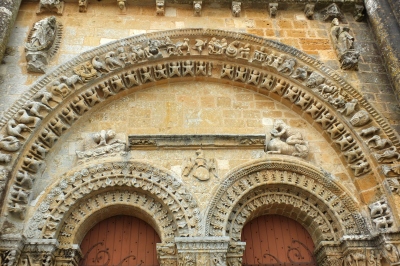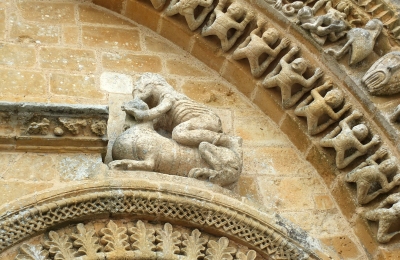The next morning
the weather had turned for the worst so we headed across country to the
Pont de Tancarville toll bridge across the Seine, and along the estuary
to reach Honfleur, where there was plenty of room at the large aire near
the harbour. We strolled past several river cruise boats to
the
busy town centre. Down a narrow street we found the Erik
Satie museum, where we caught the end of a free concert of a
few of
his less well known piano pieces and songs. We decided to miss the
guided museum tour (in French). As we left the heavens opened so we got
drenched walking back to the van.
Continuing
west along the Calvados coast, we drove through the resorts of Trouville
and Deauville, where motorhomes don't seem to be welcome
with height barriers everywhere, and stopped at Dives s
Mer where
there was a small
aire next to the modern marina. After a stroll along the massive sandy
beach, watching a group of youngsters getting ready for some sand
yachting, we set off inland, and realised that there were fuel
shortages due to industrial action, judging by the queues and closed
filling stations. Luckily we had an almost full tank, enough to last us
a few
days at our leisurely pace. We continued on minor roads to reach the
pretty Plus Beau village of Beuvron en Auge, with its typical Normandy
style timber-framed houses and flowery market square. There was a good
tourist office where we discussed Brexit (a
week before
the referendum!) with the friendly staff. We continued to Falaise the
next day, where we managed to get some diesel before heading to
the
municipal campsite, set below the impressive château where William the
Conqueror was born. The next morning we visited the
busy town
market and the Museum of Automata with its mechanised tableaux, as seen
in department store windows years ago.
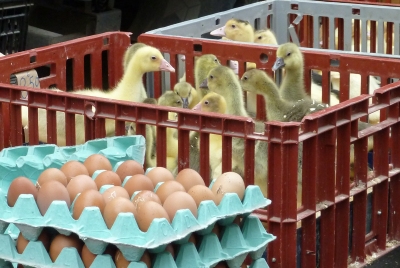
Falaise chicks in a basket
After a day with no driving, we drove west to Pont d'Ouilly and on to
Clécy to visit the large model railway layout. The owner was keen to
demonstrate it all to us, although we had to wait a while for a few
more visitors to turn up.
Continuing south we spotted some gendarmes
with a speed camera hiding behind a hedge as we left a small village, so turned
up the speed limit warning sound on our satnav, as the limits vary so
frequently around French towns. We stopped at Domfront for lunch
and looked
at the ruined château, nothing special and the town was rather run down,
with lots of empty shops. However there was an interesting church built
from reinforced concrete in the 1920's, a bit stark from the outside
but an amazing interior with Byzantine style mosaics decorating the
walls. From there we drove to Saint Fraimbault and an aire accessed by
a €1 coin operated barrier. It turned out to be an award winning 4 star
"Ville Fleurie" with attractive flower beds and a pleasant wooded
lakeside walk.
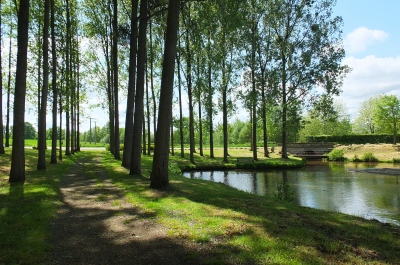
lakeside walk at Saint Fraimbault
We
decided to bypass the large town of Laval and stopped for lunch at
Château-Gontier, on the River Mayenne, with riverside parking (but no
services), for motorhomes by the large exhibition complex. There were a
few old buildings in the town centre, but we decided to miss a visit to
the large cathedral on the hilltop, and headed down to the Loire and
an overnight stop at the aire at Bouchemaine. Continuing south,
we reached Vouvant in the Forêt de Mervant-Vouvant regional
park. Another Plus Beau village and a "city of history and character",
there were many attractive buildings, an historic tower and a large
Norman church with an amazing carved doorway. A short distance away was
Mervent where we found the aire and forest walks. The area was very
quiet, although the tourist office was open, and probably livelier when
the large boating and leisure complex is open in the summer. As is often the case, the lakeside wasn't very accessible on foot.
We
decided to head for the coast, so drove across the flat Marias
Poitevin region to bypass La Rochelle, and crossed the high toll bridge to the
Île de Ré, where there were several aires listed. All the carparks had
height barriers and overnight parking was
banned, so we stopped first at the private aire at Le Bois Plage en Ré, adjacent
to Les Amis de Plage campsite.
